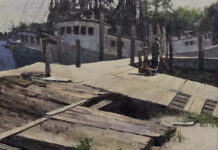Think you’ve got your plein air oil supply list nailed down? Think again. Esteemed painter John Crump takes the myth out of some plein air oil painting conventional wisdom. Whether you’re a seasoned pro or just getting started in plein air painting, you might be surprised by some of his hard-won findings.
Plein Air Supplies for Oil Painters
BY JOHN CRUMP
1. A smooth-as-glass palette. A smooth palette makes mixing color, picking it up, and cleaning so much easier when you’re done. I make my own palettes and finish them with several coats of two-pot epoxy varnish. When a palette gets a buildup of hard paint, I clean it by brushing on a little lacquer thinner, letting it soften the paint, and then scraping it off carefully with a palette knife. Note: Ordinary varnish cannot stand this treatment — it needs to be epoxy.
2. Gessoed hardboard panels. Some artists believe that if you’re using hardboard panels, they need two or three coats of gesso before you use them. I’ve tried this, but discovered that in doing so, the gesso becomes hungrier. It sucks the medium out of your paint, making the brushstrokes less fluid. I prefer giving the panels one generous coat and allowing them to dry thoroughly before using them.
3. Winsor & Newton Liquin. If your paintings dry too slowly during the winter, try using Winsor & Newton Liquin as your medium, and also mix up to 50 percent alkyd white into your (titanium) white oil. The heavy lumps of impasto color are touch-dry in 24-36 hours, while thinner paint is touch-dry overnight.
This article was featured in PleinAir Today, a weekly e-newsletter from PleinAir magazine. To start receiving PleinAir Today for free, click here.





John is an awesome plein air painter!!!
Paint conservators would not recommend these practices but old school sign painters and house painters (and faux painters, that’s me) who worked with oil/alkyd paint might.
Kerosene contains non drying ‘fat’ that in your brushes will become part of your paint. Remember the oily soot on a kerosene heater? Sign, House and faux painters often used K1 as a slower drying solvent and brush cleaner.
lacquer thinner will continue to ‘off gas’ from the softened epoxy pallet becoming part of your paint too. Off gassing goes on for a long time.
If one is not concerned with exposure to K1, epoxy or lacquer thinner, might as well use basic lead carbonate, cremnitz or ‘flake white’, PW1, for your white, it makes the fastest drying (and strongest) paint films.
Avoid mixtures of it with PW4, zinc white. Conservators have found that zinc white has made very brittle paint films, the reason many 19th and 20th century paintings have failed.
Good thing this is all happening out doors!
I use Kerosene, and got the advice from John. The non drying fat in the kerosene keeps the brushes smooth, and when the kerosene is wiped of the brushes, there is so little fat in the brush, that I think, it has no influence to the paint
about the liquin
If you want the paint to dry even faster, you can try Lukas malmittel 3. It offers some other exciting options as it dries in about 1/2 hour. I use only Lukas malmittel 3.